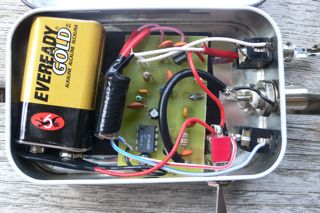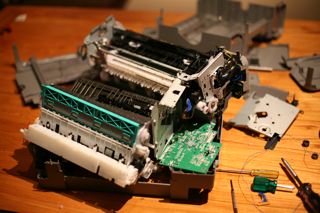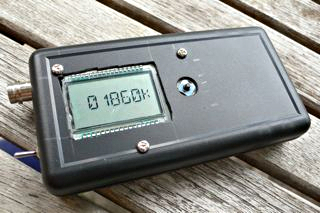 PSK-31
PSK-31 is a recent digital mode that is very
efficient in terms of bandwidth use and is excellent for keyboard to keyboard chatting on noisy HF.
I've been listening around for the distinctive warble sound on 80m and 40m for some time and hadn't found anything I could decode, then I read about 14.070Mhz (20m) and that seems to be where the action is. Several strong stations were heard without trouble.
A simple wire dipole for 20m was constructed and strung between two trees. I have a Yaesu FT-817 portable rig which has a mini-din 6 data jack on the back so an interface box (pictured above) was constructed. As I run a Mac the excellent
cocoaModem software is in use. To key the transmitter, (as the FT-817 doesn't support VOX on the data port - a great pity) I first tried making a simple vox circuit but in the end used
cocoaPTT which toggles the RTS line on a USB serial cable. One diode was used to save the radio from the +ve swing, so it just pulls PTT low to transmit, otherwise no electronics, just soldering, seems to work fine.
I called CQ, running just 5W into a very flaky antenna and was immediately called back by JA2LCN in Ogaki City, (this person seems very active).
If you run Windows there is lots of
software about for PSK31, there's also some Linux software with a reasonable GUI.
In use, you leave the radio tuned to 14.070Mhz and watch the waterfall display. When you see a signal you click between the lines and start reading. It seems like a very nice way to chat, particularly if you can touch type. (A lot of receive errors I noticed now seem to be bad typing in retrospect).
I note there's some interesting kits around for minimal, low power
transceivers designed for PSK31 use specifically. It's interesting to consider that a little board like this, a roll of wire, antenna tuner and a laptop and you can chat half way around the world pretty easily.
 The gutters here at Marxy Manor are full of leaves and when it rains they overflow in all the wrong places.
The gutters here at Marxy Manor are full of leaves and when it rains they overflow in all the wrong places.
 Heard about this on the wonderful
Heard about this on the wonderful 



 I'm building the new
I'm building the new 

 Stephen, VK2BLQ, has been selling off his old projects and I picked up an 80m double sideband radio he built for $5.
Stephen, VK2BLQ, has been selling off his old projects and I picked up an 80m double sideband radio he built for $5. Following on from my last post, I got something similar working with an ATTiny85. This sample code does a slow sweep from 10Mhz up a bit. It's just a demo, the bit I've been looking for myself and couldn't find was how to just say sendFrequency().
Following on from my last post, I got something similar working with an ATTiny85. This sample code does a slow sweep from 10Mhz up a bit. It's just a demo, the bit I've been looking for myself and couldn't find was how to just say sendFrequency().
 Been playing with the AD9851 DDS for a while now using other people's software mostly written in assembly language that I find rather hard to get my head around. Finally tonight, with the help of
Been playing with the AD9851 DDS for a while now using other people's software mostly written in assembly language that I find rather hard to get my head around. Finally tonight, with the help of  I share an interest in good quality headphone audio with many including
I share an interest in good quality headphone audio with many including  I'm experimenting with antennas again and wanted a way to string up a dipole so that I could easily pull it down and make adjustments.
I'm experimenting with antennas again and wanted a way to string up a dipole so that I could easily pull it down and make adjustments. 
 In preparation for the next NSW Home Brew group meeting at Dural where we will be having a power meter calibrate-athon, I've built a crazy box for my simple QRP power meter. Haven't tried to calibrate it but the output of a
In preparation for the next NSW Home Brew group meeting at Dural where we will be having a power meter calibrate-athon, I've built a crazy box for my simple QRP power meter. Haven't tried to calibrate it but the output of a  Just built a nifty little kit, the
Just built a nifty little kit, the  Ever since I attended a workshop on stepper motors at Dural conducted by Peter VK2EMU I've been watching for the site of an inkjet printer by the side of the road and this morning there was a rather wet Canon calling me...
Ever since I attended a workshop on stepper motors at Dural conducted by Peter VK2EMU I've been watching for the site of an inkjet printer by the side of the road and this morning there was a rather wet Canon calling me...


 After hearing about them at a NSW Home Brew meeting, I purchased an AD9851 on eBay and have had about a week of frustration trying to program the thing. You need to send them a clocked 40 bit sequence to set the frequency.
After hearing about them at a NSW Home Brew meeting, I purchased an AD9851 on eBay and have had about a week of frustration trying to program the thing. You need to send them a clocked 40 bit sequence to set the frequency. Next steps are to put this in a nice box with more robust buttons, output filtering and amplifier. In summary, this gives the builder a very flexible oscillator for not many dollars. It's certain to become a core part of many future radios coming out of the Marxy lab in the future.
Next steps are to put this in a nice box with more robust buttons, output filtering and amplifier. In summary, this gives the builder a very flexible oscillator for not many dollars. It's certain to become a core part of many future radios coming out of the Marxy lab in the future. I've put this prototype in a little box to serve as a portable digital signal generator. Tried to run it off two AA batteries but the voltage was a little low for the 30Mhz oscillator to work reliably. (The AVR Butterfly is perfectly happy at low voltage though).
I've put this prototype in a little box to serve as a portable digital signal generator. Tried to run it off two AA batteries but the voltage was a little low for the 30Mhz oscillator to work reliably. (The AVR Butterfly is perfectly happy at low voltage though).
 Saw this little
Saw this little  I'm using a laptop at work and have been searching the shops for some contraption to lift the laptop up so the screen is at eye height (I'm using an external keyboard and mouse).
I'm using a laptop at work and have been searching the shops for some contraption to lift the laptop up so the screen is at eye height (I'm using an external keyboard and mouse).




